I would try to post a minimal working example, but unfortunately this problem just requires a lot of pieces so I have stripped it down best I can.
First of all, I'm using a simple script that simulates pressing keys through a function call. This is tweaked from here.
import ctypes
SendInput = ctypes.windll.user32.SendInput
PUL = ctypes.POINTER(ctypes.c_ulong)
class KeyBdInput(ctypes.Structure):
_fields_ = [("wVk", ctypes.c_ushort),
("wScan", ctypes.c_ushort),
("dwFlags", ctypes.c_ulong),
("time", ctypes.c_ulong),
("dwExtraInfo", PUL)]
class HardwareInput(ctypes.Structure):
_fields_ = [("uMsg", ctypes.c_ulong),
("wParamL", ctypes.c_short),
("wParamH", ctypes.c_ushort)]
class MouseInput(ctypes.Structure):
_fields_ = [("dx", ctypes.c_long),
("dy", ctypes.c_long),
("mouseData", ctypes.c_ulong),
("dwFlags", ctypes.c_ulong),
("time",ctypes.c_ulong),
("dwExtraInfo", PUL)]
class Input_I(ctypes.Union):
_fields_ = [("ki", KeyBdInput),
("mi", MouseInput),
("hi", HardwareInput)]
class Input(ctypes.Structure):
_fields_ = [("type", ctypes.c_ulong),
("ii", Input_I)]
def getKeyCode(unicodeKey):
k = unicodeKey
curKeyCode = 0
if k == "up": curKeyCode = 0x26
elif k == "down": curKeyCode = 0x28
elif k == "left": curKeyCode = 0x25
elif k == "right": curKeyCode = 0x27
elif k == "home": curKeyCode = 0x24
elif k == "end": curKeyCode = 0x23
elif k == "insert": curKeyCode = 0x2D
elif k == "pgup": curKeyCode = 0x21
elif k == "pgdn": curKeyCode = 0x22
elif k == "delete": curKeyCode = 0x2E
elif k == "\n": curKeyCode = 0x0D
if curKeyCode == 0:
return 0, int(unicodeKey.encode("hex"), 16), 0x0004
else:
return curKeyCode, 0, 0
def PressKey(unicodeKey):
key, unikey, uniflag = getKeyCode(unicodeKey)
extra = ctypes.c_ulong(0)
ii_ = Input_I()
ii_.ki = KeyBdInput( key, unikey, uniflag, 0, ctypes.pointer(extra) )
x = Input( ctypes.c_ulong(1), ii_ )
ctypes.windll.user32.SendInput(1, ctypes.pointer(x), ctypes.sizeof(x))
def ReleaseKey(unicodeKey):
key, unikey, uniflag = getKeyCode(unicodeKey)
extra = ctypes.c_ulong(0)
ii_ = Input_I()
ii_.ki = KeyBdInput( key, unikey, uniflag + 0x0002, 0, ctypes.pointer(extra) )
x = Input( ctypes.c_ulong(1), ii_ )
ctypes.windll.user32.SendInput(1, ctypes.pointer(x), ctypes.sizeof(x))
I stored this in a file named keyPress.py.
Using this, I wanted to make a simple program that could detect what the user was typing while they were typing it in the python shell. The idea was that I would use msvcrt.getch() to get the key pressed, then the script above to make it seem like it was still pressed (and "echo" the key press in a sense")
Here is the code:
import keyPress
import msvcrt
import threading
def getKey():
k = msvcrt.getch()
# Escaped Key: 224 is on the keyboard, 0 is on the numpad
if int(k.encode("hex"), 16) == 224 or int(k.encode("hex"), 16) == 0:
k = msvcrt.getch()
if k == "H": k = "up"
elif k == "P": k = "down"
elif k == "K": k = "left"
elif k == "M": k = "right"
elif k == "G": k = "home"
elif k == "O": k = "end"
elif k == "R": k = "insert"
elif k == "I": k = "pgup"
elif k == "Q": k = "pgdn"
elif k == "S": k = "delete"
# Fix weird linebreak
if k == "\r":
k = "\n"
return k
def actualGetKeys():
while True:
k = getKey()
keyPress.PressKey(k)
keyPress.ReleaseKey(k)
def getKeys():
p = threading.Thread(target=actualGetKeys)
p.daemon = True
p.start()
I stored this in a file named keyGet.py.
This is all working very well, except that whenever the user presses enter, the first key isn't displayed on the screen. The console still knows that you typed it, it just doesn't show up there. Something like this:
What is happening? I've tried many many things and I can't seem to get this behavior to change.
I am now able to get this essentially working, as in it can capture key input asynchronously while a script is running, and execute with the text of each command you type into a command prompt (so you could, say, store these to an array). The only problem I am running into is something like this:
I know this is due to essentially having to have a robot retype their input after they type it, I'm just wondering if there is a way to do this that prevents that input from actually being displayed when the robot types it, so it acts just like the user would expect.

